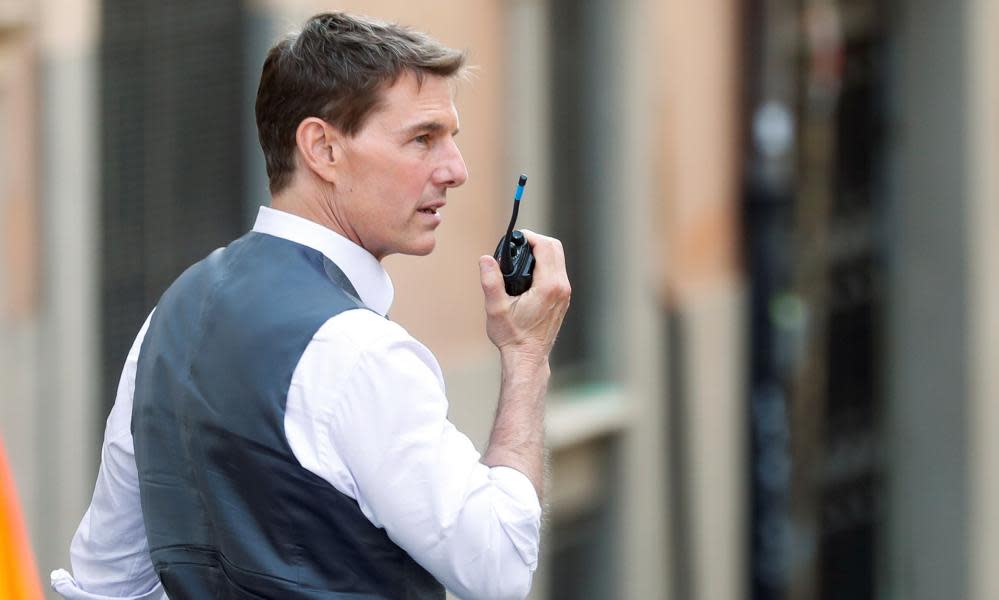How did Mission: Impossible 7 become one of the most expensive films ever?

Intentionally or not, Tom Cruise has become the public face of pandemic film-making. His long-awaited Top Gun sequel has been booted down the release schedules even more than No Time to Die; its original release date of July 2019 was first pushed back a year, then held there for two more because of Covid. When the world (prematurely) thought that the virus had been sent packing in 2020, he made a special video about how much he loves going to the cinema. And then, of course, there was the leaked audio of him (correctly) going full nut-nut at his crew for breaching social distancing rules. Tom Cruise owns the pandemic, just like he owns running in films and sending out cakes at Christmas.
However, this has come at a price. Yesterday, Variety revealed that the production budget for Cruise’s upcoming Mission: Impossible 7 has ballooned beyond all proportion. Thanks to a frantic shooting schedule that effectively saw Cruise and director Christopher McQuarrie racing around the world trying to beat the disease – stopping and starting production seven different times since February 2020 – the film has now burned through $290m.
The budget increased with each shutdown, since the cast and crew remained employed throughout the downtime. Set pieces requiring the expensive closure of vast swathes of cities – including, according to Variety, an elaborate action scene during Carnival Venice – were cancelled and rescheduled over and over again. And then, with the rest of the world sheltering in place, the production found itself unable to locate much in the way of essential film-making materials like lumber.
As if you need to be told, this is a huge amount of money. Not only is it a full $100m more than the previous instalment – 2018’s Mission: Impossible - Fallout – but it shoves the film into the upper echelons of the most expensive movies ever made. And it’s no exaggeration to say that the air is awfully thin up there.
Adjusted for inflation, the current budget – which, let’s not forget, doesn’t cover the gargantuan expense of publicity and marketing – makes Mission: Impossible 7 the 13th most expensive film ever made. And while in some circumstances this could be seen as an absurd power-move, since some of the other most expensive films (like Avengers: Endgame and Titanic) are also the most successful, but nor is it something to boast about. The 12th most expensive film is the notorious flop Waterworld, and the 11th most expensive is the even more notorious flop John Carter. The eighth is Justice League, a film with a budget so high that it took more than $500m and still somehow lost Warner Bros $60m.
Another problem for Mission: Impossible 7 is that it’s being filmed back-to-back with Mission: Impossible 8, rumoured to be the last in the series, and Cruise is apparently so determined to land the cliffhanger between the two that the first film won’t be released until the second one is completed. So far, this means that the seventh instalment will come out next summer and the eighth in 2024, but that may still change. And, needless to say, the longer you sit on a film, the more expensive it becomes.
And if that wasn’t enough, then cinemas still face an uphill battle getting anyone to actually go there. Although Spider-Man: No Way Home punched an almighty hole in the side of the post-Covid box office, it stands surrounded by colossal flops. The Last Duel, West Side Story, The Matrix 4 and Moonfall have all died a horrible death theatrically, and there’s little sign that things will let up any time soon. Additionally, frosty China-US relations mean that a film like Mission: Impossible 7 can no longer count on a hefty Chinese box office windfall.
On paper, Mission: Impossible 7 is sailing into a perfect storm. If a bad wind blows on the film, however gently, then we could be looking at an all-time trainwreck. That said, I remain optimistic.
Because the Mission: Impossible films are as close to perfect as action films can get. They’re huge, propulsive, visceral beasts that do everything in their power to drag the audience along with them. One of my favourite ever cinema moments came halfway during Fallout when, after an electrifying motorbike chase through Paris, you could hear everyone in the entire theatre remembering to breathe again. It’s becoming slightly cliched to say that films deserve to be watched on the largest screen possible, but it remains absolutely true for the Mission: Impossible films. They’re joyous, giddy spectacles that deserve to be watched collectively.
Cruise has come through worse than this before. When Sumner Redstone attempted to cancel him back in 2006, effectively banning him from Paramount, Mission: Impossible 3 quickly became the lowest grossing of the series. But he’s bounced back phenomenally well, with the last three Mission: Impossible films becoming the highest grossing of his entire career. Mission: Impossible 7 is going to be a success, even if I have to go to the cinema 1,000 times to see it.

 Yahoo Movies
Yahoo Movies 
